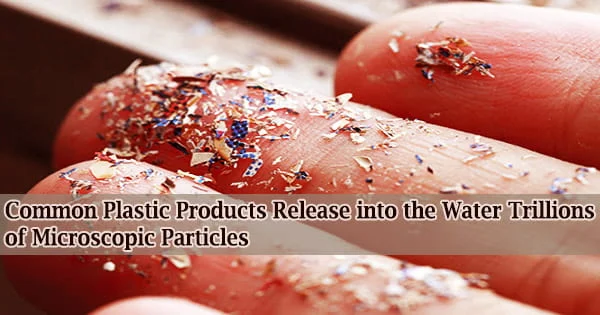Plastic is all around us, from the grocery bags we use at the store to everyday objects like shampoo and soap bottles. Plastics are found in both large things and the small particles that are discharged from them. These tiny plastics have the potential to contaminate the environment and enter our bodies through ingestion.
In order to comprehend these minuscule polymers better, scientists at the National Institute of Standards and Technology (NIST) have now examined a few extensively used consumer goods.
They discovered that hot water causes plastic objects to emit trillions of nanoparticles into the water every liter. Environmental Science and Technology is the name of the scholarly magazine where the NIST researchers submitted their findings.
“The main takeaway here is that there are plastic particles wherever we look. There are a lot of them. Trillions per liter. We don’t know if those have bad health effects on people or animals. We just have high confidence that they’re there,” said NIST chemist Christopher Zangmeister.
There are many various kinds of plastic materials, but they are all constructed of polymers, which are compounds made of many linked-together big molecules either naturally or artificially. The oceans and many other habitats have been found to contain minute fragments of these bigger plastics by scientists. They are divided into two categories by researchers: microplastics and nanoplastics.
While nanoplastics are typically less than one-millionth of a meter (one micrometer) and most can’t even be seen with a regular microscope, microplastics are typically smaller than five millimeters in length and can be seen with the naked eye.
Recent research has demonstrated that various consumer goods that contact or retain liquids, such as nylon plastic tea bags and polypropylene (PP) infant bottles, release plastic particles into the surrounding water.
The NIST researchers examined two categories of commercial plastic goods in their study: single-use hot beverage cups, such as coffee cups, and food-grade nylon bags, such as baking liners transparent plastic sheets placed in baking pans to produce a nonstick surface that reduces moisture loss.
Low-density polyethylene (LDPE), a flexible soft plastic film frequently used as a liner, was applied to the drinking cups they examined. The drinking cups lined with LDPE were submerged in water for 20 minutes at 100 degrees Celsius (212 degrees Fahrenheit).
The researchers first had to figure out how to find the nanoparticles that were emitted from these plastic items.
In the last decade, scientists have found plastics wherever we looked in the environment. People have looked at snow in Antarctica, the bottom of glacial lakes, and found microplastics bigger than about 100 nanometers, meaning they were likely not small enough to enter a cell and cause physical problems.
Christopher Zangmeister
“Imagine having a cup of water in a generic to-go coffee cup. It could have many billions of particles, and we would need to figure out how to find these nanoplastics. It’s like finding a needle in a haystack,” Zangmeister said.
So, he and his colleagues had to use a new approach. “We used a way of taking the water that’s in the cup, spraying it out into a fine mist, and drying the mist and all that’s left within the solution,” said Zangmeister.
The nanoparticles are separated from the remainder of the fluid using this method. The method itself has been employed in the past to find minute airborne particles.
“So, we’re not reinventing the wheel but applying it to a new area,” said Zangmeister.
The mist’s nanoparticles were organized according to size and charge after it had dried. The particles might then be fed into a particle counter with a specific size in mind, such as nanoparticles of approximately 100 nanometers. After being exposed to a heated vapor of the alcohol butanol, the nanoparticles were quickly cooled.
The alcohol condensed, increasing the size of the particles from nanometers to micrometers, which greatly increased their observability. A computer application automates and controls this procedure by counting the particles.
Placing the nanoparticles on a surface and observing them with the methods known as scanning electron microscopy which produces high-resolution images of a sample using a beam of high-energy electrons and Fourier-transform infrared spectroscopy which records the infrared-light spectrum of a gas, solid, or liquid would also allow researchers to determine the chemical composition of the nanoparticles.
When combined, all of these methods gave a more complete picture of the nanoparticles’ size and make-up.
The average size of the nanoparticles, according to the researchers’ analyses and observations, was between 30 and 80 nanometers, with few exceeding 200 nanometers. In addition, compared to single-use beverage cups, the concentration of nanoparticles released into hot water from food-grade nylon was seven times higher.
“In the last decade, scientists have found plastics wherever we looked in the environment. People have looked at snow in Antarctica, the bottom of glacial lakes, and found microplastics bigger than about 100 nanometers, meaning they were likely not small enough to enter a cell and cause physical problems,” said Zangmeister.
“Our study is different because these nanoparticles are really small and a big deal because they could get inside of a cell, possibly disrupting its function,” said Zangmeister, who also stressed that no one has determined that would be the case.
The plastics that come in contact with the food we eat or the water we drink are subject to FDA regulation. To decide what is safe, the government has put in place criteria and safety procedures.
The FDA’s scientists put these polymers through rigorous testing and track how much plastic mass is lost while they are in hot water. For instance, the FDA has found that high-temperature circumstances can safely cause food-grade nylon (such as that used in tea bags) to lose up to 1% of its mass.
One-tenth of one percent of the mass was lost in the NIST study utilizing their new technique, which is much less than the current FDA safety limitations.
According to Zangmeister, there exist tests for nylon plastics but none for quantifying the amount of LDPE that is leaked into water from samples like coffee cups. The results of this study may be useful in developing such tests.
Zangmeister and his team have also examined other consumer goods and materials, including clothing, cotton-polyester blends, plastic bags, and water kept in plastic pipes. Future research in this area will be able to take advantage of the findings from this study as well as those from the other types of materials examined.
“Most of the studies on this topic are written toward educating fellow scientists. This paper will do both: educate scientists and perform public outreach,” said Zangmeister.
















